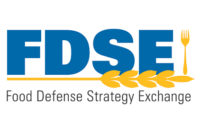Terrorism is a growing concern. But, how does terrorism relate to food, and why should food manufacturers be concerned?
Food is an attractive target because everyone eats. And, in the future, terrorists can use the food supply to create fear, inflict public harm and damage food company brands. This extends to the refrigerated and frozen food industry, where for example, a frozen food manufacturer in Japan recalled over 6 million products in 2013 after an employee adulterated the products with malathion, a pesticide. This incident resulted in almost 3,000 cases of consumer illness, forced the company to shut down and caused the parent company’s stock to plummet.
To protect our food and food systems, we must implement food defense strategies that mitigate the risk of food terrorism, sabotage and intentional adulteration.
Food defense planning can reduce the potential impact of intentional adulteration on food systems. Many food defense strategies will be similar to, and others will complement, existing food safety efforts. However, there are differences. Food safety processes protect food from unintentional adulteration by known contaminants in the production environment, whereas food defense initiatives protect food from intentional adulteration by unknown contaminants. Robust food defense plans should consider three components that comprise a food defense threat—motivation, capability and vulnerability.
Every food defense threat begins with a person or group of people with motivation to harm the public, company or brand, or in the case of economically motivated adulteration, with motivation to create fraudulent financial gain. Thus, understanding potential adversaries with motivation and access to production processes is a crucial first step in addressing food defense.
It is also essential to consider both external and internal adversaries, as many food defense incidents have been carried out by people with legitimate access to food production processes. Opportunities to reduce food defense threats by addressing motivation include considering how external risks in a specific operating environment may impact production, understanding engagement of the workforce and creating a food defense culture within a facility that includes peer and managerial support.
Understanding capabilities of potential adversaries is a second key aspect in food defense planning. Capabilities vary in the food world, and include at a minimum, the ability to access the food production system, the knowledge and tactics to disrupt the system and the ability to evade detection. Tactics to disrupt the system may include introduction of adulterants, cyber-attacks on production control systems and cargo theft. Protections will need to address each of the basic capabilities in addition to addressing potential tactics of disruption. Adulterants may be physical, chemical, biological or radiological with historical examples of incidents available for all categories. In addition, most concerning adulterants will maintain a higher risk combination of availability, severity, resistance, detectability, notoriety, infectiousness and treatability. For example, chemicals like pesticides and cleaning agents have a high concern because of their ease of availability, potentially high severity, resistance to production processes and low detectability in many current food production environments.
Finally, a food production system must have vulnerability for a food defense attack to be successful. Understanding and addressing these vulnerabilities is a key aspect of the most recent Food Safety and Modernization Act (FSMA) final rule addressing intentional adulteration. Food manufacturers will need to understand their production processes, including all inputs, and consider each and every step from the perspective of an intelligent adversary intending to do harm.
Overall, improving food defense processes and practices to protect food production from terrorism and sabotage will require thinking about production facilities and processes in a manner that is different but complementary to current food safety practices. Although food defense attacks are more infrequent than food safety incidents, the ability of both to cause economic and public health harm is significant. How prepared are you and your company to address food defense threats?



